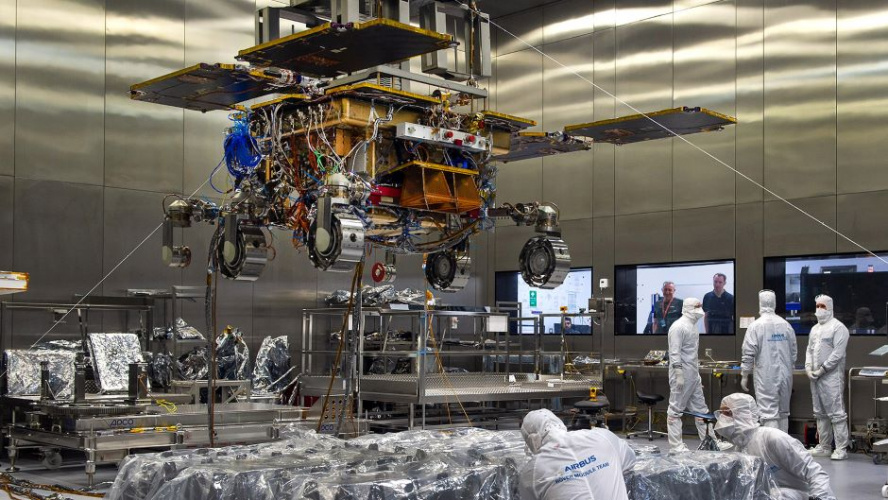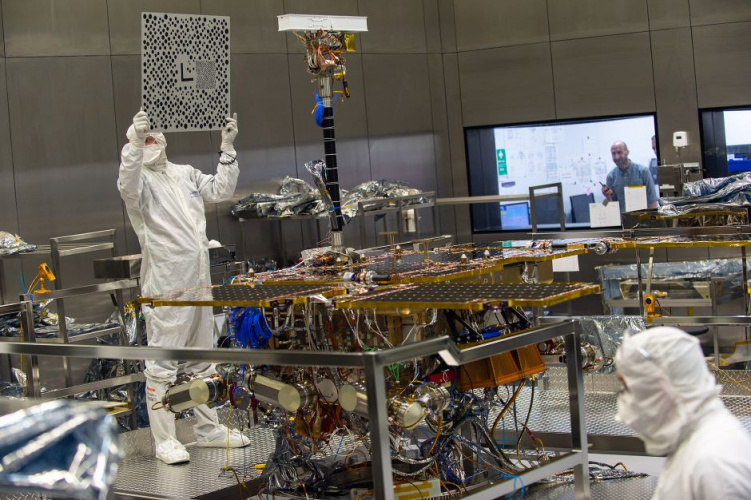 Stuart Nathan visits Airbus Defence and Space, where the Mars rover Rosalind Franklin is being prepared to undergo an interplanetary journey
Stuart Nathan visits Airbus Defence and Space, where the Mars rover Rosalind Franklin is being prepared to undergo an interplanetary journey
It’s been a long time coming. Possibly the most ambitious mission in the European Space Agency’s history has reached its decisive point, with the preparation of the Mars Rover Rosalind Franklin to leave its cradle, the Stevenage assembly facility of Airbus Defence and Space, to undergo its final series of tests. Once on Mars, in March 2021, it will begin trundling around the landscape, where it will undertake the most exhaustive set of experiments to date in the attempt to determine whether Mars has ever hosted life – and, indeed, whether it still does. Its mission is currently scheduled to take nine months, although most of the team involved believe this is likely to be extended.

Before being named after the pioneering British x-ray crystallographer best remembered for her role in determined the structure of DNA, Rosalind Franklin carried the name of its mission, ExoMars. It’s a mission that has undergone many changes since it was first proposed in 2003. The lead structures engineer on the rover, Abbie Hutty, a friend of The Engineer and a judge on our Collaborate to Innovate awards, notes that it is the only mission in ESA history to have gone through five final design reviews: the point at which the design is supposed to be frozen. This reflects the differing approaches the agency has taken to the mission, from collaborating with NASA to its current status as a collaboration with the Russian space agency Roscosmos.
“We were going to have one big rover," Hutty explained, "then two small rovers with a Skycrane landing system, then one big rover with a Skycrane, and then we finally decided on the collaboration with Roscosmos with one big rover and a parachute/dampers landing system.”
Up until yesterday (27th August) that one big rover was in the purpose-designed and -built bioclean suite at Stevenage, where its nine instruments produced by the various European universities and institutions taking part in the mission were integrated into its chassis. Biological control is particularly vital as, one of the technicians told me, “the worst possible thing would be to go to Mars and find life, but then to find out that life came from Stevenage.” Such constraints also prevented the use of certain materials in the rover, such as rubber. This made the design of the wheels and suspension system particularly challenging, with the team developing deformable all-metal wheels from titanium and steel components that mimic and match the properties of rubber tyres.
Even at this stage of rover development, one of the test models (codenamed Bryan) was being put through its paces at the Stevenage Mars yard yesterday. The Mars yard is a glorified sandpit, designed to mimic as closely as possible the terrain the rover will explore. The sand is carefully selected to match the particle size and characteristics of the Martian surface and has been baked in an autoclave to achieve the required levels of dryness. The undulating surface is littered with rocks of various sizes, the largest of which are well-disguised fakes. These test both the rover’s ability to traverse rough ground, with the wheels capable of climbing a rock their own size, and the crucial autonomous navigation system that will allow the vehicle to plot its own course, avoiding the need for control over the two-hour time-lag between Mars and Earth. Bryan is a curious top-heavy-looking construction, its high centre of mass mimicking some of the effects of the low Martian gravity. In 2011, The Engineer covered field tests of Bryan's sister rover model, Bridget, on the volcanic landscape of Tenerife.
____________________________________________________________
Related articles
UCL scientist develops camera for Mars rover
Replica Martian soil set to aid development of ESA rovers
UK confirms €1.4bn of spending in ESA projects
_____________________________________________________________
Rosalind now has several months of testing ahead of her. Looking oddly vulnerable in her stowed configuration, with her six wheels folded under her chassis and tall mast holding her optical system, Pancam, folded between two solar panels, she was being readied for packaging in an ultraclean transport crate for a journey by rail to Toulouse, where a battery of tests will confirm that the build quality is sufficient to withstand the eight-month cruise across the inner solar system to Mars and the scheduled length of the ExoMars mission. Once these tests are complete, Rosalind (or Rosie, as most of the team at Airbus call her – although the real Rosalind Franklin would not have approved. She hated having her name abbreviated) will cross France again to a facility run by prime contractor Thales Alenia Space (TAS) in Cannes, where she will be integrated into the two other main systems crucial to sending her to Mars, the German-made cruise spacecraft and the Russian descent module.
Her next stop will be the Roscosmos launch site at Baikonur, Kazakhstan, where the final components of the Rover, three radioisotope heating units to keep crucial instruments warm in the frigid Martian environment, will be fitted. This, Abbie Hutty explained, can only be done at the last minute because in the ambient earth conditions, the heat of the radioactive plutonium in the units risks overheating the rover, so all the cooling systems will be running full blast until the vehicle reaches space. Rosalind is scheduled to reach Baikonur in April 2020, although a precise launch date is yet to be scheduled.

Ahead of this, more testing will take place on the parachutes that will lower the Russian descent module to the surface. The module has two chute systems, a small supersonic parachute that opens high in the atmosphere, and a much larger one that deploys once the speed has dropped to a manageable level. Two tests earlier this year saw both chutes tear on deployment which, according to ExoMars mision manager Pietro Baglioni, has been determined to be due to the way the chute membranes were packed and extracted. NASA, which experienced similar problems when landing the Spirit and Opportunity rovers in 2004, is advising on this problem, Baglioni said. In November, a test will take place in Oregon, using a stratospheric balloon to drop a dummy mass from 30 km altitude with a mortar firing the supersonic chute out of its container.
The mood at Stevenage was somewhat subdued, with the ExoMars team emotional at this landmark point in their long-running project. “This has been the last seven years of my life; I keep thinking what am I going to do with all that brain space now?” Abbie told me. The answer is probably to build another rover: at the next ESA ministerial meeting in Spain in November, the UK is to propose leading a mission to return samples from Mars to Earth. This will involve building a Rover to retrieve samples cached by NASA’s next Mars rover, currently codenamed Mars 2020, which is scheduled to launch next year. This “Fetch Rover” will then ferry the sample to a launching platform and package it into a capsule that will be launched into orbit where another ESA spacecraft will pick it up, package it into a biocontainment system and transfer it to a NASA Earth entry capsule. With the Airbus team’s experience on assembling and building Rosalind Franklin, it is the most likely candidate to build the Fetch Rover. “So the next few months are going to be devoted to conversations about ‘well that’s a bit that worked, so we can do it again,’ and ‘for pity’s sake, let’s try that a different way this time’,” said Hutty.
It seems that engineers concerned that the UK’s forthcoming exit from the European Union will affect missions like this need not worry; the UK Space Agency is keen to stress that ESA is not an EU organisation and that the UK’s ambitions in space exploration remain undimmed. Concerns remain about other types of space mission, however, with discussion still taking place about the UK’s global positioning capability since pulling out of the Galileo programme after being told it would not be able to access the secure part of satellite constellation’s systems. A member of the UCL team which built PanCam told me “we have to prove once again that we are capable of being a good-faith collaborator in such missions. Nobody doubts that on the level of individual scientists or institutions, as we are all working with the same people we’ve been collaborating with for years, and everybody’s confident about the competence and attitude of institutions like Oxford, Cambridge, UCL and Surrey. But unfortunately, there are concerns about the bureaucratic level above those institutions.”










Water Sector Talent Exodus Could Cripple The Sector
Maybe if things are essential for the running of a country and we want to pay a fair price we should be running these utilities on a not for profit...